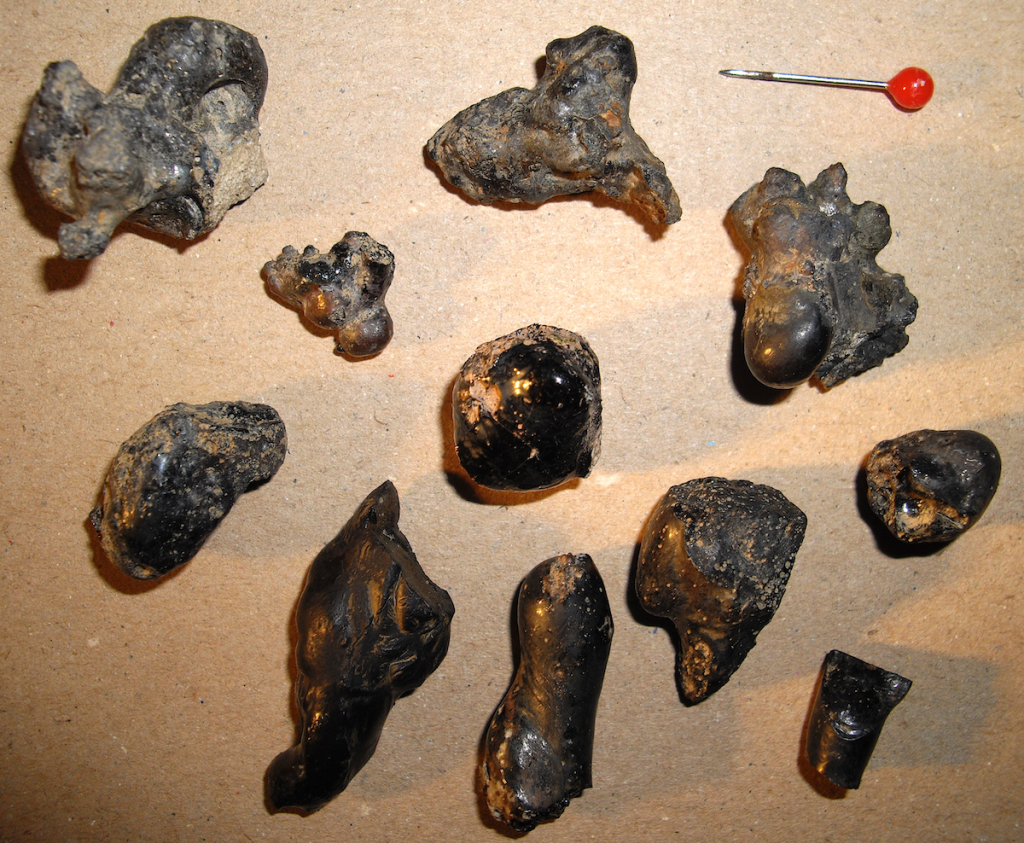Tektites are well-known gravel-size natural glasses that according to current knowledge form in the very early process of impact cratering by melting and/or vaporizing of superficial soil and rocks ejected as melt or vapor from the impact crater. On reentry in the atmosphere and cooling, the glass bodies exhibiting characteristic shapes fall to Earth where they form part of the impact ejecta. By definition tektites that are smaller than 1 mm are called microtektites. Although the origin of tektites from impact events is generally accepted the exact mode of formation is not well understood.
In the Chiemgau meteorite crater strewn field impact glasses are found widespread in various formations, and tektite-like bodies of a dense black glass with vesicles have attracted considerable attention (Fig. 1).

Fig. 1. Dense black glass particles from the Chiemgau impact strewn field frequently exhibiting tektite-like shape and twisted form similar to irghizites from the Zhamanshin impact crater. These are NOT the Chiemgau microtektites! – Click to enlarge.
Outside the crater strewn field in the foothills of the Alps at some 1500 m altitude (Fig. 2) a systematic search for impact fallout has revealed not only abundant tiny iron silicide particles (e.g., minerals xifengite and gupeiite) but also microtektites widely distributed in the soils (Fig. 3).
 Fig. 2. Location map for the Chiemgau impact meteorite crater strewn field and the sites of the microtektite finds. Google maps. – Click to enlarge.
Fig. 2. Location map for the Chiemgau impact meteorite crater strewn field and the sites of the microtektite finds. Google maps. – Click to enlarge.
They show the very typical splash shapes like spheres, teardrops and irregular dumbbells (Fig. 3). They are fully transparent and have a mostly yellowish-brownish-grayish color. Bubble inclusions are frequent.
 Fig. 3. Typically shaped microtektites from the soil in the foothills of the Alps near the Chiemgau impact crater strewn field. Optical microscope images, 100 µm scale bar in each case.
Fig. 3. Typically shaped microtektites from the soil in the foothills of the Alps near the Chiemgau impact crater strewn field. Optical microscope images, 100 µm scale bar in each case.
The SEM micrographs in Fig. 4 especially point to the in part very strange surface features and bizarre forms exhibiting micrometer-sized glass filaments and twisted bodies.

Fig. 4. SEM images of microtektite-like glass particles.
Note the tiny, micrometer-sized glass filaments (lower
right) of the particle over it.
Relations
Microtektites are known, e.g., from the North American strewn field (cores from the Deep Sea Drilling Project), from the Australasian tektite strewn field, from the Ivory Coast strewn field and seem to be associated with the Chicxulub KT impact and Late Eocene impacts. A problem with proposed microtektite occurrences may arise from a possible confusion with spherules of an origin other than from impact vapor/melt solidification especially when a direct relation with an impact site is lacking. Even volcanic spherules may show dumbbell and teardrop shapes, while industrially produced microscopic glass spheres (e.g. from fly ash) have in general no teardrop or dumbbell counterparts. A comprehensive consideration of the various possibilities including volcanic, man-made and even organic matter is given by Glass & Simonson (2013).
In the case of the Chiemgau impact microtektites a confusion with volcanic or man-made glass particles can be excluded with a high degree of probability since the very nearby really existing impact site and the exceptionally typical shape of known microtektites provide the simplest explanation for their origin. Nevertheless, a thorough analysis of their composition and a highly magnifying SEM imagery of their surfaces are in progress. Perhaps, some more insight into the general process of microtektite formation – in this case possibly as an impact vapor plume condensate – can be attained.
Reference
Glass, B. P. and Simonson, B.M. (2013): Distal Impact Ejecta Layers: A Record of Large Impacts in Sedimentary Deposits. – Impact Studies, 400 p., Springer.













































